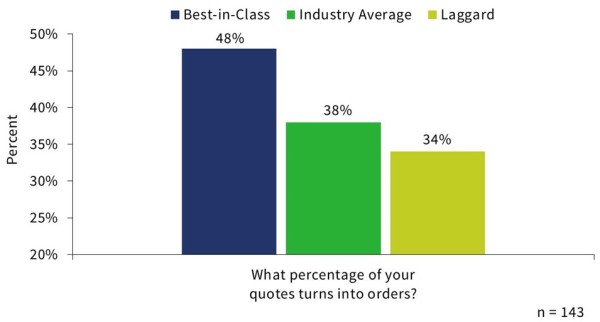For as long as any of us can remember, salespeople have been handed scripts, talking points, and decision trees designed to guide them through the process of sealing their deal. Given the complexities of modern selling, real-time data exchange, and the ever-more educated 21st century buyer, these elements are no longer sufficient methodologies to create a competitive support system for the contemporary seller. Our Aberdeen CPQ Research Report analyzes the business value of, and recommends best practices to complement, the Configure / Price / Quote suite of sales enablement technologies.
Everything in business-to-business (B2B) selling revolves around numbers: achieving higher thresholds of commission payments by exceeding quota, losing one’s job by falling too far short of quota, evaluating the potential of each territory, and even the number points or badges competitively earned within internal gamification initiatives. From the standpoint of sales leadership and executive management, the efficient execution of sales operations activities may be represented by no more valuable a metric than the overall “batting average” associated with Aberdeen’s recent survey question, “What percentage of your sales quotes turns into real orders?”
Figure I: Best-in-Class Companies Set the Bar High for Sales Batting Averages

When the 143 companies completing Aberdeen’s newest Sales Effectiveness survey are segmented into performance cohorts, we see in Figure 1 a dramatic 30% delta (48% vs. 37%) between Best-in-Class and All Other organizations around this crucial KPI. How do these top performers achieve such significantly better results?
Time is Money: Providing Your Sales Team with More of Each
Best-in-Class companies do not necessarily achieve better business results because they have better products then their competitors, although Aberdeen’s Product Innovation & Engineering research practice certainly gives them plenty of advice on doing so. Neither are top-performing sales organizations bigger than other firms; in fact, the current data set shows Best-in-Class companies reporting 7.8% smaller in annual average revenue, $488M vs. $529M. Where they do differentiate themselves from under-performers, however, is around better management of the most valuable commodity of front-line reps and channel partners: more time to execute on the art and science of selling.
Figure 2: Best-in-Class Efficiencies in Sales Workflow

Figure 2 provides significant insight into how the most successful sales organizations streamline their sales workflow by reducing the internal time, friction, and red tape that are too often associated with getting complex B2B deals done. Who among us has never seen a great sales opportunity slip into the next month or quarter, because “those guys in Legal keep getting in my way,” or grown frustrated because “I keep having to update the proposal because no one around here knows what our standard quote for red widgets is supposed to look like?” These scenarios play out every day in thousands of annoying ways, primarily because the workflow of many contemporary selling environments has not been sufficiently investigated with the prime goal in mind of maximizing the selling time of on-staff reps and external selling partners.
The Best-in-Class, however, create 10% fewer iterations of the typical sales proposal or quote than All Others, saving not only sales reps measurable time, but also that of their buyers and customers, by reducing proposal errors and disconnects. They also involve an average of 18% fewer internal stakeholders in the development and approval proposals, quotes, and RFP responses, reducing the possibility that a colleague’s vacation, travel, or even a bad mood will contribute to deal-killing friction. Finally, if we acknowledge that reducing the number of hours spent searching for vital sales content – proposal templates, pricing guides, marketing assets – is a sales-enhancing activity, then the 18% advantage reported by Best-in-Class companies is certainly admirable. What, then, are these top performers doing in order to achieve these game-changing “time is money” advantages?
CPQ Leads to PDQ
The implementation of sales-centric configure / price / quote (CPQ) solutions is clearly on the rise, at least among top-performing organizations. The current Aberdeen research data set reveals that Best-in-Class firms are 63% more likely than All Others (52% vs. 32%) to plan on increasing their CPQ deployments over the next 12 months , with 43% of the Best-in-Class and only 27% of All Others planning increased activity around blending these technologies during the next year. A similar 59% delta exists between high and low performers around plans to further integrate CPQ solutions with the core CRM platform. When we analyze the survey responses differently, comparing the year-over-year performance changes of all respondents indicating they currently have a CPQ solution in place and actively utilized, with non-adopters, we see the results in Figure 3:
Figure 3: CPQ Deployments Yield Stronger Annual Business Results

Read the full report here.
This article was syndicated from Business 2 Community: Configure / Price / Quote: Better, Faster Sales Deals Enabled
More Sales & Marketing articles from Business 2 Community:




